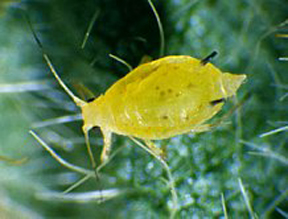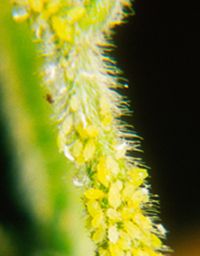Source: University of Nebraska Extension
By Tom Hunt, Extension Entomology Specialist; Keith Jarvi, Wayne Ohnesorg, Extension Educators
Soybean aphids have recently been found in field surveys in northeast Nebraska from Battle Creek to Ponca. Numbers are extremely low, as is typical this time of year, but this does signal it is time to start scouting.
All aphids were found on the newest leaves, so we imagine colonization was fairly recent. The good news is that we also observed soybean aphid natural enemies in these fields, so they may hold the populations in check, or at least slow their population growth.
The relatively mild weather is favorable for soybean aphids, so make sure and check fields at least once a week. Soybean aphid population growth can be quite rapid, and regular monitoring of soybean aphid populations is key to effective management.
Soybean Aphid Description
The soybean aphid is soft bodied, light green to pale yellow, less than 1/16-inch long, and has two black-tipped cornicles (cornicles look like tailpipes) on the rear of the abdomen (Figure 1).
 Figure 1. Soybean aphid.
Figure 1. Soybean aphid.
It has piercing-sucking mouthparts and typically feeds on new tissue on the undersides of leaves near the top of recently colonized soybean plants. Later in the season the aphids can be found on all parts of the plant, feeding primarily on the undersides of leaves, but also on the stems and pods.
Soybean Aphid Occurrence in Nebraska
Soybean aphids have been reported in most soybean producing regions of Nebraska, although the highest and most economically damaging populations typically occur in northeastern Nebraska.
In much of the soybean aphid's range northeast and east of Nebraska, significant aphid infestation has often occurred during vegetative stages of soybean. These infestations then undergo rapid population growth to reach high populations during the flowering stages (R1, R2).
During most years in Nebraska, however, very few aphids have been found during the vegetative stages. This may be in part because in Nebraska we have less of the soybean aphid's overwintering host, common buckthorn, than in states further east and north.
We usually find a few in late June to early July, as soybeans are entering or in R3 (beginning pod stage), that we begin to regularly find aphids. Nebraska aphid populations can reach economically damaging populations (Figure 2) in late July, but most reach economically damaging populations in August, when soybeans are in the mid-reproductive stages (R4-R5). In some years there are many fields where the aphid populations peak in late R5 (beginning seed) to early R6 (full seed). Most economically damaging populations occur in northeast Nebraska.
 Figure 2. Soybean aphid populations can quickly build into the thousands under the right conditions.
Figure 2. Soybean aphid populations can quickly build into the thousands under the right conditions.
Of course, there are always exceptions to any rule, so one should always be watchful for soybean aphid colonization and population increase.
Soybean Aphid Injury to Soybean
Soybean aphids injure soybeans by removing plant sap with their needle-like mouthparts. Symptoms of soybeans infested by soybean aphid may include yellowed, distorted leaves and stunted plants.
A charcoal-colored residue also may be present on the plants. This is sooty mold that grows on the honeydew that aphids excrete. Honeydew by itself makes leaves appear shiny. Soybean plants appear to be most vulnerable to aphid injury during the early reproductive stages. Heavy aphid infestations during these stages can cause reduced pod and seed counts.
Aphid Scouting Methods
There are two methods to scout and determine if an insecticide treatment is warranted; a conventional scouting method using the 250 aphid/plant economic threshold and a speed scouting method.
Conventional, 250 Aphid/Plant Method
- Begin scouting soybean fields once or twice a week in late June/early July. Check 20-30 randomly selected plants in various areas of each field. Aphids are most likely to concentrate at the very top of the plant, although they will move onto stems and within the canopy as populations grow and/or the plant reaches mid to late reproductive stages. If a tree line or woodlot is adjacent to the soybean field, make sure and include a few sampling locations near these areas. Soybean aphids are often found first in the parts of soybean fields near wooded areas.
- Counting aphids is not as difficult as it may at first seem. First, walk to a random spot in the field. Pull a plant and turn it upside down and give it a quick scan to see where the aphids are located. Get a feel for what 10 or 20 aphids look like and count by 10s or 20s.
- The current threshold for late vegetative through R5 stage soybean is 250 aphids/plant with 80% of the plants infested and populations increasing (see above for details). Thresholds for early R6 have yet to be determined, but are likely in the 400-500 aphids/plant range. Insecticide treatment done during or after mid-late R6 has not been documented to increase yield.
Speed Scouting Method
- ·This method uses a spreadsheet adapted from a sampling plan developed by the University of Minnesota. It is different from conventional scouting in that it relies on the number of "infested" plants. Plants are considered "infested" when there are 40 or more aphids on a plant. The scout does not have to count or estimate the number of aphids on a plant to determine whether it has reached the threshold of 250 aphids per plant. One simply determines if a plant is infested and enters this in the spreadsheet. The spreadsheet then recommends further scouting or treatment options based on the number of "infested" plants in a given area.
- This tool is freely available as a web-accessible UNL Extension Circular Aphid Speed Scout (EC1582) to be used in the field on mobile devices (e.g., smart phone, computer, iPad) or as a free iPad App available in the iTunes store at Aphid Speed Scout.
Soybean Aphid Management
The current recommended economic threshold for late vegetative through R5 stage soybeans is 250 aphids per plant with 80% of the plants infested and populations increasing. Depending on economic conditions, this generally gives you about 5-7 days to schedule treatment before populations reach economically damaging levels.
If populations do not increase during these 5-7 days, you may be able to eliminate or delay treatment. Determining if the aphid population is actively increasing requires several visits to the field. Factors favorable for aphid increase are relatively cool temperatures, plant stress (particularly drought), and lack of natural enemies.
Soybean aphids in Nebraska usually reach the economic threshold and require treatment in late July through August, with a few fields requiring treatment earlier in July. Treatment during this period usually is enough to keep aphid populations from resurging because there is not enough time for populations to build-up before they would naturally leave the fields in late August and early September. The earlier a field is treated, the greater the chance that any surviving aphids can later reproduce or new aphids can repopulate the field.
Remember, insecticide treatment also kills many natural enemies, so any aphids that do re-infest a field are not constrained by predators and other natural controls. Even insecticides with a relatively long residual cannot last when insecticide treatment is done in early or mid-July, particularly during a year when aphid populations are thriving. If one has to treat early, make sure to closely monitor the field until early September.
Another practice that can result in aphid population resurgence is unwarranted insecticide treatment, either because fields were treated well before the threshold was met or fields were treated along with an herbicide (in some cases a fungicide), regardless of aphid presence. These treatments kill natural enemies and are usually done relatively early so there is plenty of time for aphids to resurge, or re-colonize a field. Aphid populations below or even at the economic threshold do not cause yield loss, so treating before populations reach 250 aphids/plant only increases the probability of aphid resurgence.
In addition, we have observed that many fields support a non-increasing, low population of aphids (e.g., less than 100 aphids/plant) through August. Treating these fields would be a waste of time and money.
Tank-mixing insecticides with glyphosate or other herbicides can be problematic because application methods for herbicides (e.g., lower pressures, large droplet producing nozzles) are not optimal for good insecticide efficacy. Tank-mixing with fungicides can be effective because application methods for fungicides and insecticides require high water pressure for adequate penetration and coverage, however, only conduct this practice if soybean aphid thresholds are met.
Additional sources of information can be accessed through the UNL Entomology Website and CropWatch.






Post a comment
Report Abusive Comment